Spring ![]() Summer
Summer ![]() Fall
Fall ![]() Winter
Winter ![]()

Mussel Rock, August 2011 (Jennifer Rycenga)
You know those nearly annual occurrences that make the national news, of some cliff-side house slipping into the sea in northern California? Well, here's where it happens: you can see the places where the high cliff on the southern border of Daly City has slipped into the canyon below. Rock slides and dangerous erosion have shaped the geography of Mussel Rock Park.
Mussel Rock's place in history, though, was assured over 100 years ago: it is the closest point to the epicenter of the 1906 San Francisco earthquake! Altogether, when you hike here, you should be aware that you live on an unstable planet!
That being said, Mussel Rock Park is the most extensive birding site in Daly City, though accessing it is best done through Pacifica. Its claim to fame is the presence of unusual winter ocean-going sea ducks, including a regular flock of Black Scoters, the occasional Harlequin Duck and White-winged Scoter, and the very unusual Red-necked Grebe. However, there are more possibilities at this large location than just these rarities. The offshore rocks provide areas for all three cormorants species, Black Oystercatcher, Pigeon Guillemot and Western Gulls. The land species include nesting Song and White-crowned (Nuttall's subspecies) Sparrows, Wrentit, and California Scrub-Jay among others. What is not obvious to the eye when you arrive is that the area has some marshy places, as you move east inside the first plateau. Look for cattails and listen for the sharp chips of Common Yellowthroat.
The area is built on a landfill, and is used by para-gliders as a landing and takeoff area. There is also a contiguous transfer station used by Allied Waste, which attracts large gull flocks: this is a location that has not been studied assiduously for rare gulls, but probably should be.
The trails are easy to spot and follow, being wide and gravely, though sometimes steep. You can take them down, in a zig-zag pattern to just above the shore, to the foot of Mussel Rock. The shoreline here can yield rocky shorebirds, including Wandering Tattler, Black Turnstone, and Surf Scoter; the open beach to the north can hold Sanderling, Whimbrel, Willet, and other shorebirds.
You can follow the trails uphill to the north, although this does not reveal many changes in habitat. During coastal migration, this spot might be worth a try for hawks, but there are better places to explore at Mori Point in Pacifica, or San Bruno Mountain.
Brant, Canada Goose, Gadwall, American Wigeon, Northern Pintail, Greater Scaup, Surf Scoter, Common Goldeneye, Common Merganser, Red-breasted Merganser, Ruddy Duck, Horned Grebe, Eared Grebe, Western Grebe, Clark's Grebe, Rock Pigeon, Eurasian Collared-Dove, Mourning Dove, Anna's Hummingbird, Black Oystercatcher, Killdeer, Whimbrel, Long-billed Curlew, Marbled Godwit, Black Turnstone, Surfbird, Sanderling, Dunlin, Least Sandpiper, Wilson's Snipe, Red-necked Phalarope, Spotted Sandpiper, Wandering Tattler, Willet, Parasitic Jaeger (late summer-early fall), Common Murre, Pigeon Guillemot, Marbled Murrelet, Ancient Murrelet, Black-legged Kittiwake, Bonaparte's Gull, Heermann's Gull, Short-billed Gull, Western Gull, California Gull, Herring Gull, Iceland Gull thayeri, Glaucous-winged Gull, Glaucous Gull, Caspian Tern, Forster's Tern, Elegant Tern, Red-throated Loon, Pacific Loon, Common Loon, Sooty Shearwater, Brandt's Cormorant, Pelagic Cormorant, Double-crested Cormorant, Brown Pelican, Great Blue Heron, Great Egret, Snowy Egret, Turkey Vulture, White-tailed Kite, Northern Harrier, Sharp-shinned Hawk, Cooper's Hawk, Red-shouldered Hawk, Red-tailed Hawk, Great Horned Owl, Belted Kingfisher, Downy Woodpecker, Nuttall's Woodpecker (unusual at this location), Northern Flicker, American Kestrel, Peregrine Falcon, Pacific-slope Flycatcher, Black Phoebe, Say's Phoebe, Hutton's Vireo, Warbling Vireo, California Scrub-Jay, American Crow, Common Raven, Chestnut-backed Chickadee, Northern Rough-winged Swallow, Tree Swallow, Barn Swallow, Bushtit, Wrentit, Golden-crowned Kinglet, Ruby-crowned Kinglet, Red-breasted Nuthatch, Pygmy Nuthatch, Blue-gray Gnatcatcher, House Wren, Pacific Wren, Marsh Wren, Bewick's Wren, European Starling, Northern Mockingbird, Swainson's Thrush, Hermit Thrush, House Sparrow, American Pipit, House Finch, Purple Finch, Lesser Goldfinch, American Goldfinch, Fox Sparrow, Dark-eyed Junco, White-crowned Sparrow, Golden-crowned Sparrow, Savannah Sparrow, Song Sparrow, Lincoln's Sparrow, California Towhee, Spotted Towhee, Western Meadowlark, Red-winged Blackbird, Brown-headed Cowbird, Brewer's Blackbird, Hooded Oriole (unusual at this location), Orange-crowned Warbler, Common Yellowthroat, Yellow Warbler, Yellow-rumped Warbler, Townsend's Warbler, Hermit Warbler (migration), Wilson's Warbler, Black-headed Grosbeak
In this guide, "rarities" are defined as those species given an County Abundance Code of 4, 5, or 6.
Long-tailed Duck (2014), Red-necked Grebe (many years), White-winged Scoter (many years), Black Scoter (easiest place to see them in the county), Harlequin Duck (2010, 2011, 2012, 2013, 2014), Rock Wren (2012), Blackpoll Warbler (2020), Vesper Sparrow (2020)
The parking lot for Mussel Rock (which is not maintained in excellent shape) is reached at the end of Westline Road. The best approach, from any starting point, is to reach the junction of Manor Drive and SR 1. From there, go north on Palmetto Avenue, take a left on Westline, and go to the end (being careful not to drive into the transfer station). The parking lot's main problem comes from its abundant ruts and pockmarks.
Red Markers: Parking Area or Trail Head
Hover mouse pointer over marker, or click marker, for identification.
There are no fees associated with this area.
It is illegal to be in the park after sunset.
Steep gravel paths might pose difficulty for some; wear good hiking boots. This area is built on an old landfill, so there might be archeological levels of garbage revealed during wet weather seasons or after landslides. Temperatures are variable within the park, so dressing in layers is a good idea (as it usually is in the Bay Area). If an earthquake strikes, leave the area: you are safe from tsunamis on this cliff, but not from landslides. The area is used by dogs and their walkers, who usually have some off-leash canines. This parking lot is also used by bored youths, so don't leave valuables in your car.
There are no facilities on the site. However, this is very close to the shopping areas and restaurants at Pacifica Manor.
To put it mildly, the city of Daly City does not highlight Mussel Rock Park on its website. The best contact number related to Mussel Rock would be the Parks Department under the Public Works division, 650-991-8015.
Mussel Rock Park is a hotspot in eBird, with 134 species recorded. Data exists for forty-six of forty-eight time quadrants. The eBird hotspot information page is here.
The iNaturalist 'place' marker is up and running but not nearly full enough!
Sequoia Audubon has led one field trip here, in 2011, and worked with a coastal cleanup crew at this site as well.
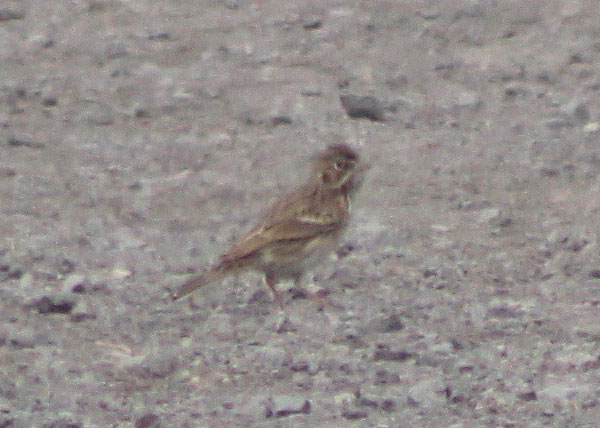
Vesper Sparrow, near the trailhead during fall migration, September 2020 (Cédric Duhalde)
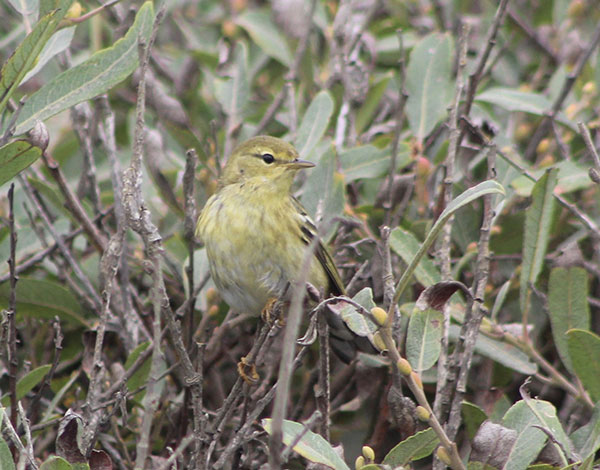
Fall migrating Blackpoll Warbler, October 2020 (Cédric Duhalde)
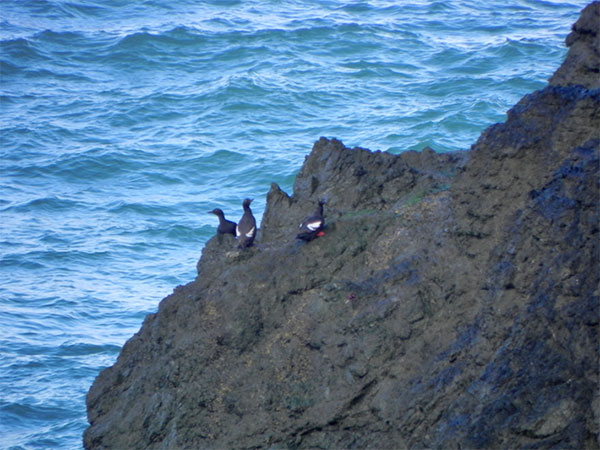
Pigeon Guillemots, Mussel Rock, August 2011 (Jennifer Rycenga)
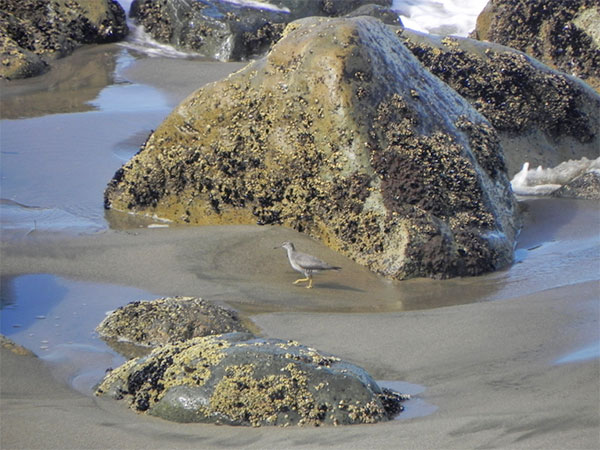
Wandering Tattler, Mussel Rock, August 2011 (Jennifer Rycenga)
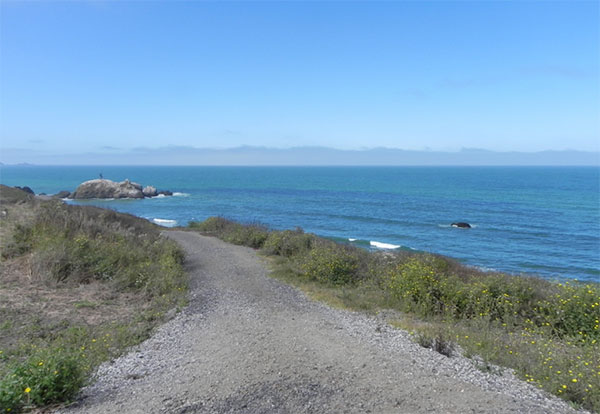
Trail leading to Mussel Rock, August 2011 (Jennifer Rycenga)
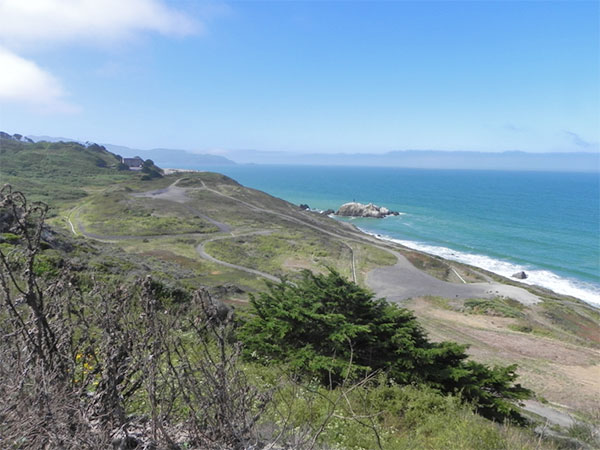
Panorama of Mussel Rock Park, looking south, August 2011 (Jennifer Rycenga)

Cove preferred by Black Scoters in winter, just north of Mussel Rock proper, viewed from the parking area. Mussel Rock, August 2011 (Jennifer Rycenga)
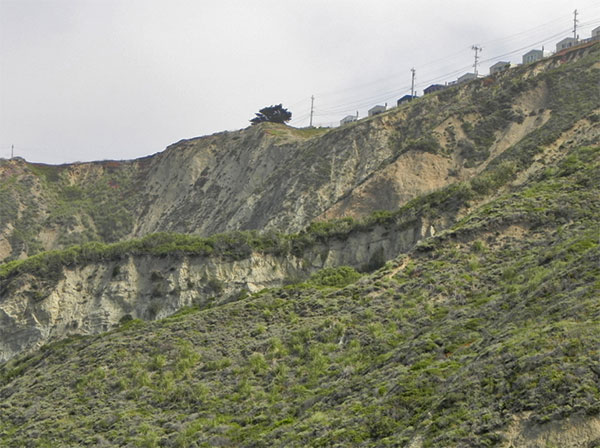
Houses along cliff, threatened by landslides and seismological activity. Mussel Rock, August 2011 (Jennifer Rycenga)
Author: Jennifer Rycenga, Laurie Graham and Jeff Fairclough, Uploaded: